Rotorcraft Theory
5.0(1)
5.0(1)
Card Sorting
1/57
Earn XP
Study Analytics
Name | Mastery | Learn | Test | Matching | Spaced |
|---|
No study sessions yet.
58 Terms
1
New cards
The Definition of a Rotorcraft
A heavier than air aircraft with rotary wings or rotor blades that generate lift by rotating around a vertical mast.
2
New cards
Parameters for rotorcraft
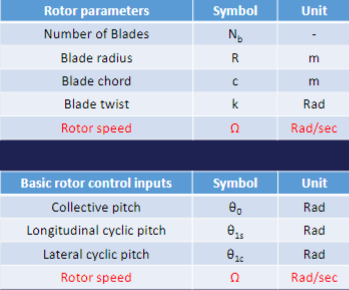
3
New cards
Why was a multi-rotor system used in the early rotor system development?
To balance the torque of each rotor system and to balance the rolling moment in forward flight.
4
New cards
What are the main differences between helicopters and autogiro?
Helicopter : Powered rotor, can hover, can take of vertically, has rotor control inputs, can be large.
Autogiro: Unpowered rotor (during flight), cannot hover, most cannot take off vertically, may not have rotor control inputs, mostly small and light.
Autogiro: Unpowered rotor (during flight), cannot hover, most cannot take off vertically, may not have rotor control inputs, mostly small and light.
5
New cards
The function of a swashplate.
Allows the blade AoA to be adjusted based on azimuth angles.
A raised swashplate causes negative collective blade pitch and thus down-force.
A tilted swashplate gives cyclic blade control.
A raised swashplate causes negative collective blade pitch and thus down-force.
A tilted swashplate gives cyclic blade control.
6
New cards
The components of a swashplate.
A stationary (lower) swashplate - mounted to main rotor mast and connected to rotor controllers
A rotating (upper) swashplate - mounted to the stationary swashplate using a bearing. Allowed to rotate with the main rotor
A rotating (upper) swashplate - mounted to the stationary swashplate using a bearing. Allowed to rotate with the main rotor
7
New cards
Definition of induced velocity
The velocity increment due to the rotor.
8
New cards
What assumptions are used in the momentum theory?
The rotor provides uniform thrust over its area.
The rotor is powered and accelerates air that is otherwise at rest.
The flow is steady, inviscid, irrotational and incompressible.
The rotor is powered and accelerates air that is otherwise at rest.
The flow is steady, inviscid, irrotational and incompressible.
9
New cards
Bernoulli’s Equation
\

10
New cards
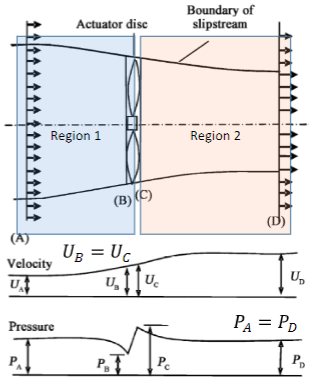
Momentum theory deduction process for climbing flight
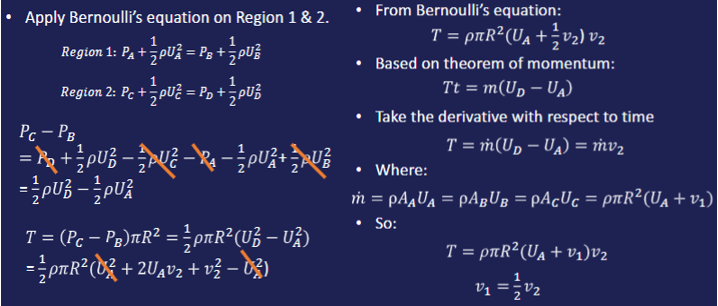
11
New cards
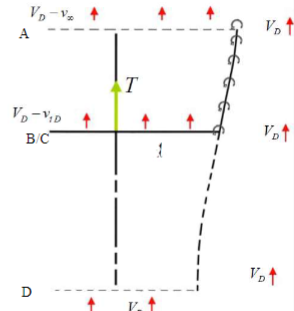
Momentum theory deduction process for descending flight (Windmill brake descent)

12
New cards
chapter 2 q4
13
New cards
What is the figure of merit?
Ratio of power associated with useful lift (ideal induced power) to total power.
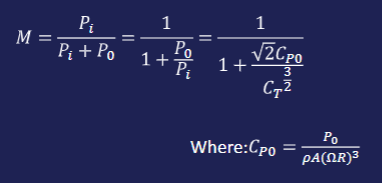
14
New cards
What is the condition of the windmill break state?

15
New cards
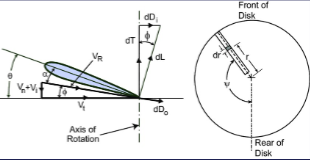
The expression of aerodynamics (dL dD) at each blade element

16
New cards
Definition of the solidity ratio
Blade Area/Disc area σ = Nc/πR
17
New cards
The function of the pre-twist angle
The pre-twist angle allows most of the blade element (especially the blade tip section) to be in the optimal attack angle to maximise the ratio between lift and drag.
18
New cards
The collective pitch control strategy to execute safe landing
Reduce the collective pitch to maintain the rotational speed. When the vehicle is close to the ground, increase collective pitch to add additional vertical acceleration to reduce the vertical speed.
19
New cards
Chapter 2 question 11. From the blade element theory, how will the rotational speed remain invariable during the auto-landing?
\
20
New cards
What’s the direction of the rotational speed and corresponding tail rotor thrust direction
Torque opposes direction of rotation, tail rotor thrust opposes the torque to compensate.
21
New cards
The influence of the flapping motion on the rotor disc lift distribution
Increasing pitch on all blades will increase thrust and the disk will tilt further back to maintain balance.
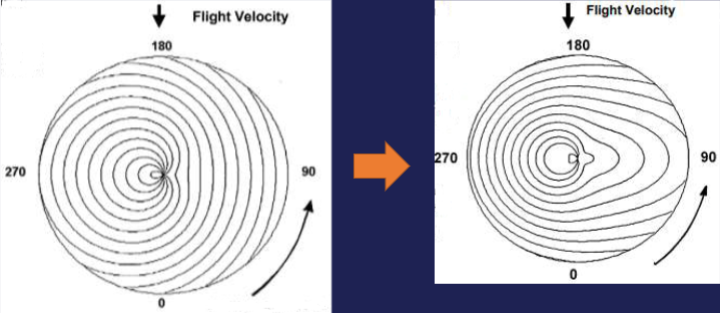
22
New cards
How does forward speed influence the flapping motion?Chapter 3 question 3
23
New cards
The assumption of the rotor-wing analogy method in forward flight
The mean rotor wake in forward flight behaves like that of an elliptical wing.
24
New cards
Definitions for Normalised velocities

25
New cards
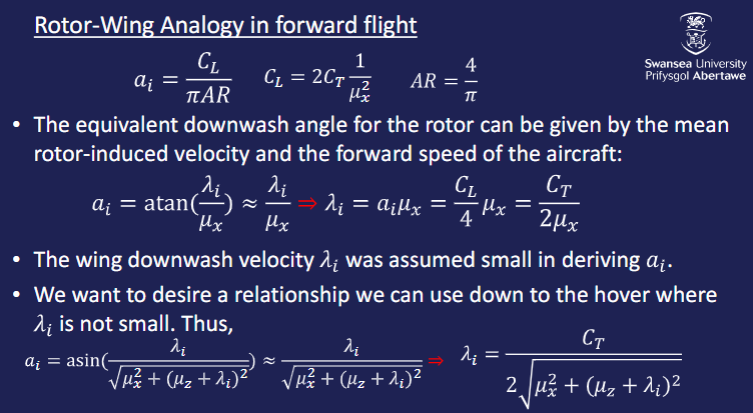
The feasibilities of the two different induced velocity calculation methods in forward flight
approximation equation only works is the normalised forward velocity is more than 0.1
26
New cards
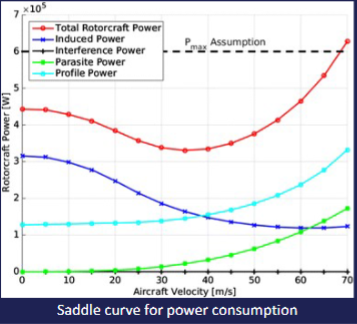
The trends and reasons for induced/profile/parasite power consumptions Vs forwards speed
The induced power is reduced as forward speed increases due to the rotor stagnant pressure is higher so the power consumption to give enough lift is reduced.
\
The parasite power at low speeds is minimal due to the dynamic pressure being close to zero. When speed increases, the dynamic pressure increases so does the parasite power.
\
The profile power increases at high speeds significantly because the attack angle increases due to the flapping motion at high speeds so profile drag increases so corresponding power consumption also increases.
\
The parasite power at low speeds is minimal due to the dynamic pressure being close to zero. When speed increases, the dynamic pressure increases so does the parasite power.
\
The profile power increases at high speeds significantly because the attack angle increases due to the flapping motion at high speeds so profile drag increases so corresponding power consumption also increases.
27
New cards
How to get the speed points to the maximum flight range and the maximum flight duration
For max flight duration, the speed point would be where minimal power consumption is around 35m/s
For maximum flight range, the speed point would be where power consumption/velocity is the lowest which is around 50m/s
For maximum flight range, the speed point would be where power consumption/velocity is the lowest which is around 50m/s
28
New cards
Which forces contribute to the natural frequency of the flapping motion and what is their influence?
Centrifugal forces - equates to mass times centripetal acceleration
Inertia force - equates to mass times linear acceleration
Aerodynamic forces - Cl, Cd, dL, dD
Inertia force - equates to mass times linear acceleration
Aerodynamic forces - Cl, Cd, dL, dD
29
New cards
Demonstrate why the flapping phase delay angle is 90 degrees.
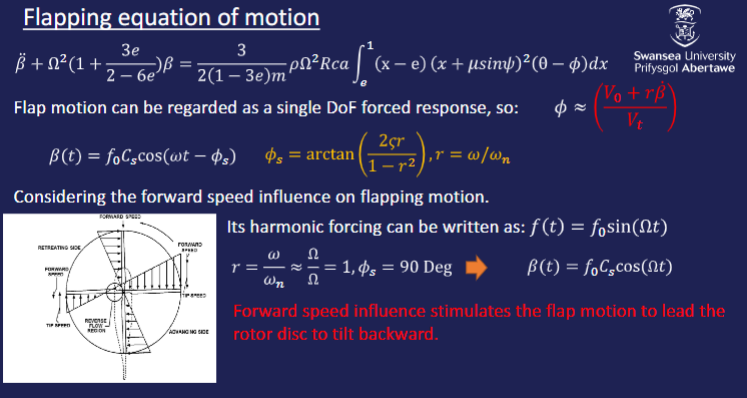
30
New cards
Chapter 5 question 3 - Influence of the flapping offset on the flapping frequency
31
New cards
What are the roles of all other excitation and their influence on flapping frequency?
Other Forces are that could influence flapping motion are:
Coriolis acceleration of the vehicle
Vehicle body angular acceleration
Vehicle body normal acceleration
Weight moment of the blade
These all have no influence on flapping frequency.
Coriolis acceleration of the vehicle
Vehicle body angular acceleration
Vehicle body normal acceleration
Weight moment of the blade
These all have no influence on flapping frequency.
32
New cards
What causes the lead-lag motion and why must the rotor have the lead-lag hinge?
The lead-lag motion is due to the Coriolis forces provided by the flap. The hinge reduces the stress on the rotor system by equalising the forces.
33
New cards
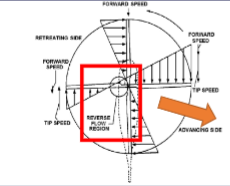
What is the influence of the reverse flow area on the rotor aerodynamics and its relationship with forward speed?
The reverse flow is the region that Vt is smaller than zero. The aerodynamics would be non-linear and drag increases significantly.
The reverse flow area increases with forward speed
The reverse flow area increases with forward speed
34
New cards
How does flapping motion revise the aerodynamics of each blade element?
The aerodynamic forces provides damping to the flapping moment.
35
New cards
How does longitudinal and lateral cyclic pitches alter the blade control angle at different azimuth angles?
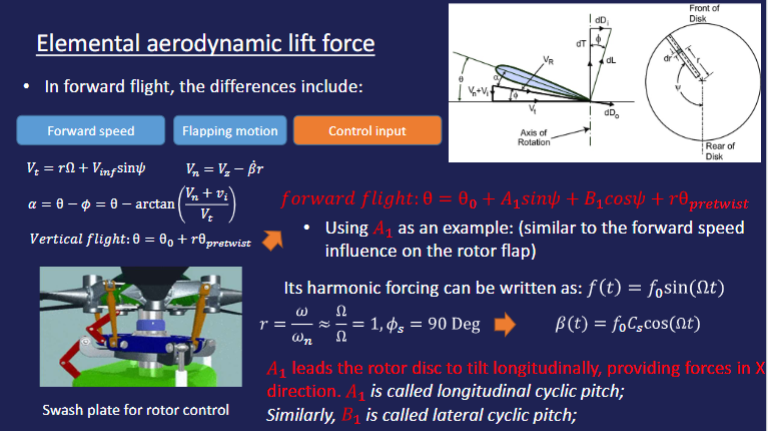
36
New cards
The flapping offset influence on the rotor control moment
Increase of the flapping offset e will reduce the flapping amplitude. This can be used to provide additional control moments for pitching and rolling control.
37
New cards
Longitudinal and lateral cyclic pitch influences on the thrust and backward/propulsive forces
If longitudinal cyclic is not equal to zero - generates thrust and backward/propulsion forces. Compensated by the flapping motion. A slight horizontal force is generated.
If Lateral cyclic is not equal to zero, only slight sideward force generated.
If Lateral cyclic is not equal to zero, only slight sideward force generated.
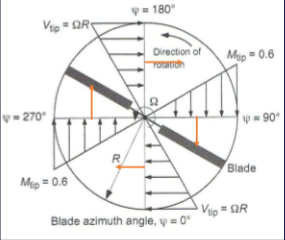
38
New cards
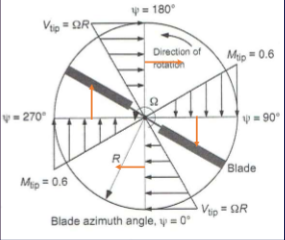
Forward speed influence on the flapping, rotor thrust and backward/propulsive forces
Due to the dynamic pressure influence, the rotor will provide backward forces
39
New cards
Sideward speed influence on the flapping, rotor thrust and backward/propulsive forces
Influence on rotor thrust - slightly increases due to the additional dynamic pressure
40
New cards
Vertical speed (collective pitch) influence on the flapping, rotor thrust and backward/propulsive forces
Reducing the Vn can be seen as an increase in the collective pitch
Influence on rotor flapping - Flapping amplitude will be higher.
Influence on forces - More drag
Influence on rotor thrust - More thrust being generated.
Influence on rotor flapping - Flapping amplitude will be higher.
Influence on forces - More drag
Influence on rotor thrust - More thrust being generated.
41
New cards
Influence of the centre of gravity on the trim characteristics
\
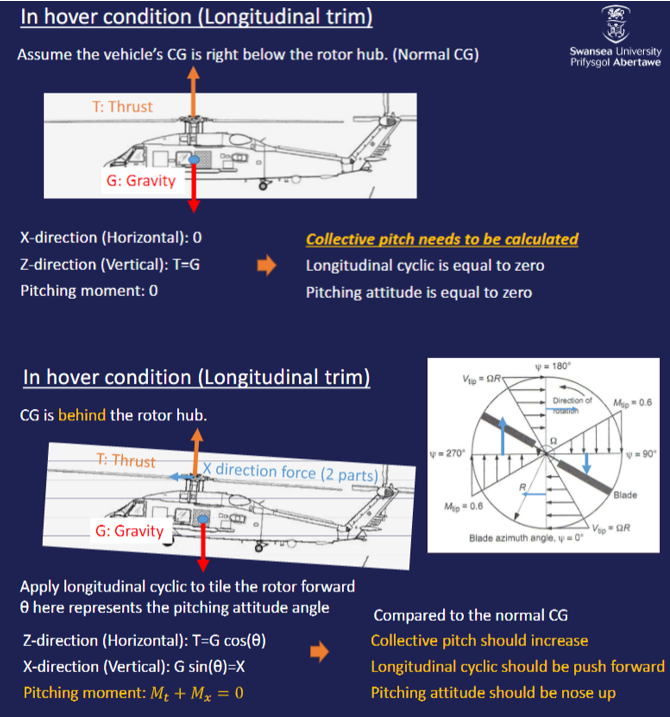
42
New cards
Which rotorcraft components provide drag, lift, and pitching moment to the vehicle in forward flight?
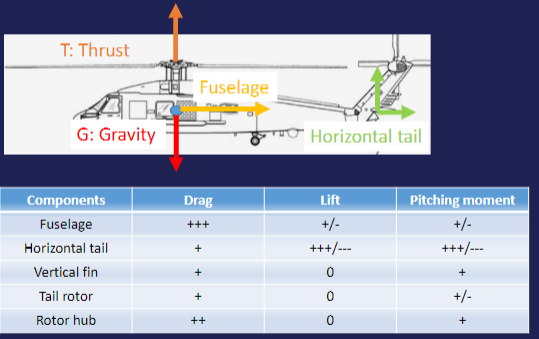
43
New cards
The trends of pitching altitude, longitudinal cyclic pitch, and the collective pitch vs forward speed for the traditional single rotor helicopter
With forward increase :
The pitching altitude will start to nose down to ensure pitching moment equal to zero.
The cyclic pitch should be pushed forward to let the rotor balance the drag of other components which increases with forward speed.
The collective pitch decreases decreases then increases (At low speed rotor dynamic pressure increase while other components drag is low. At high speed other component drag requires more thrust generated by rotor which increases rotor collective pitch)
The pitching altitude will start to nose down to ensure pitching moment equal to zero.
The cyclic pitch should be pushed forward to let the rotor balance the drag of other components which increases with forward speed.
The collective pitch decreases decreases then increases (At low speed rotor dynamic pressure increase while other components drag is low. At high speed other component drag requires more thrust generated by rotor which increases rotor collective pitch)
44
New cards
Horizontal tail’s influence on the trim characteristics
A positive lift and nose-down moment is provided by the tailplane.
Collective pitch will be reduced
Longitudinal cyclic will be pushed back
Pitching altitude will be further nose-down.
Collective pitch will be reduced
Longitudinal cyclic will be pushed back
Pitching altitude will be further nose-down.
45
New cards
The coupled effect of the tail rotor on the trim characteristics in the lateral and yawing direction
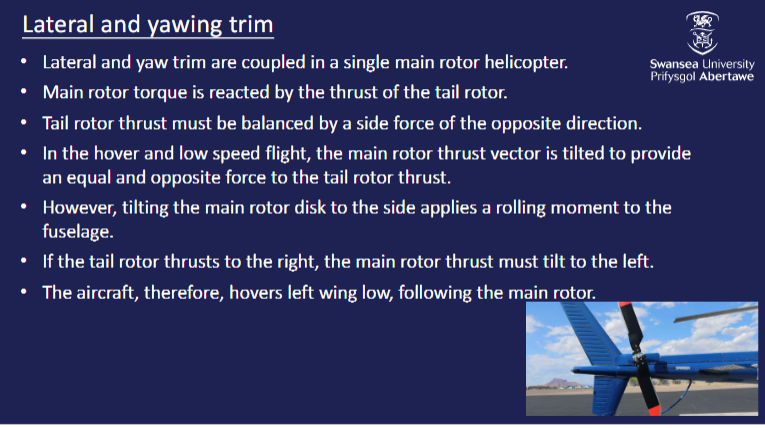
46
New cards
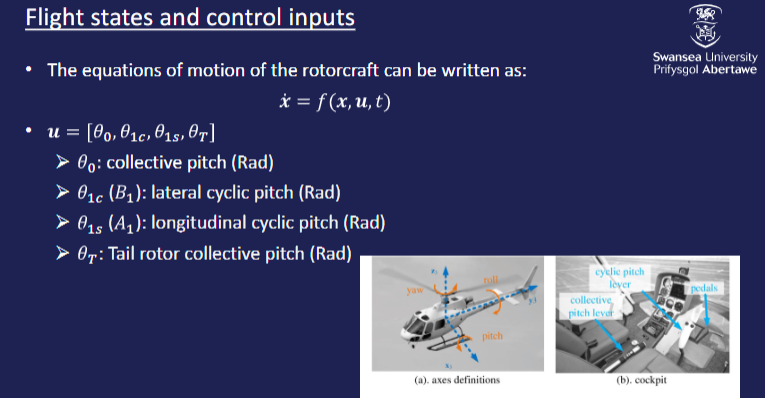
Equations of motion of the rotorcraft
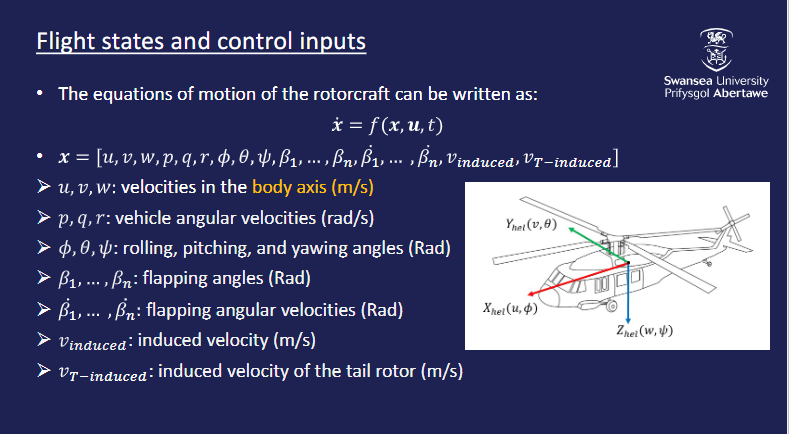
47
New cards
Which direction of damping could contribute to the stability of the vehicle?
?
48
New cards
Which rotorcraft components will make a significant contribution to the damping in different channels?
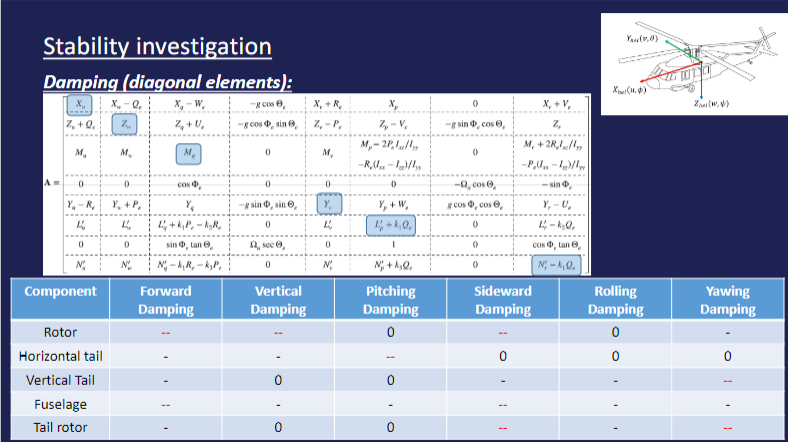
49
New cards
What is the influence of the velocity stability derivative on the vehicle and which direction of the velocity stability derivatives can contribute to the stability of the vehicle?
If Mu is positive, the rotor can provide deceleration when the forward speed increases, providing stability.
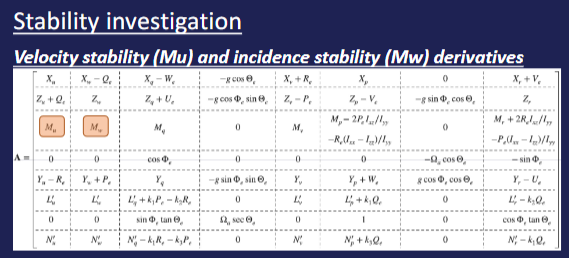
50
New cards
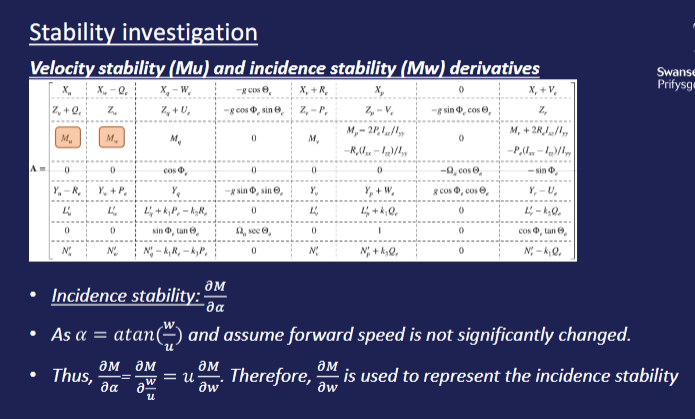
What is the influence of the incidence stability derivative on the vehicle, and which direction of the vehicle stability derivatives can contribute to the stability of the vehicle?
is dm/dw is positive **∆w will be higher and will provide instability to this vehicle.**
51
New cards
The contribution of different components on the velocity stability derivative and incidence stability derivative
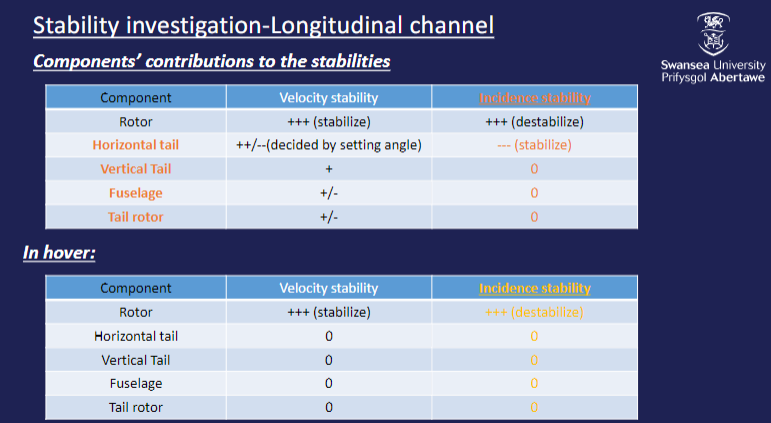
52
New cards
The control derivative of collective pitch and significant coupled control derivative
\
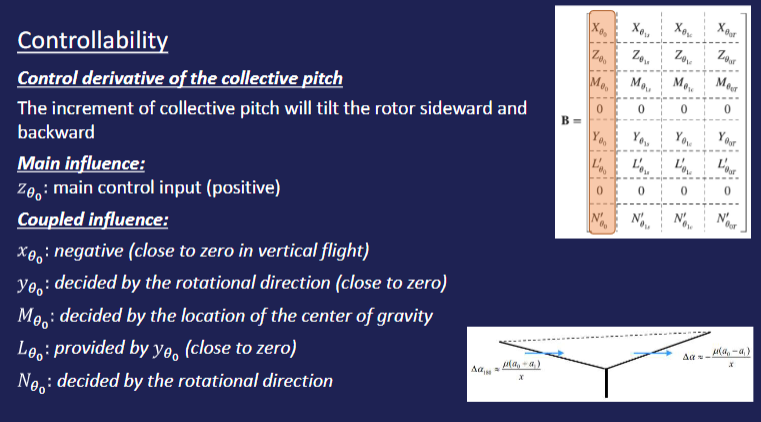
53
New cards
The control derivative of longitudinal cyclic pitch and significant coupled control derivative
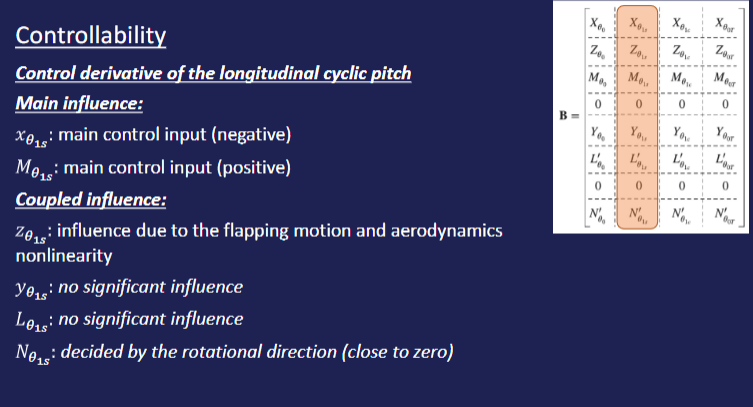
54
New cards
The control derivative of lateral cyclic pitch and significant coupled control derivative
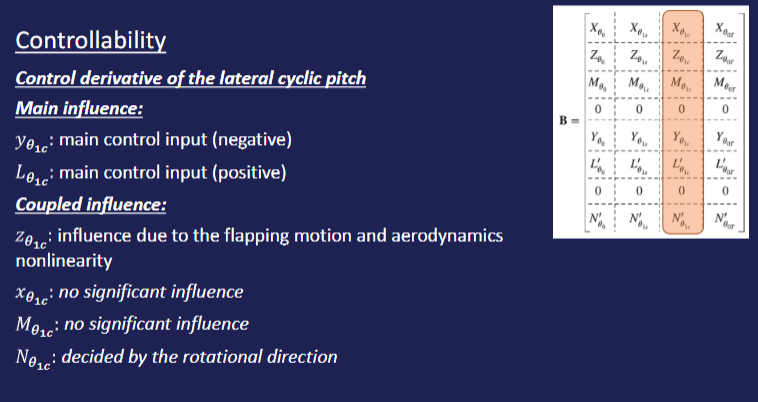
55
New cards
The control derivative of tail rotor collective pitch and significant coupled control derivative
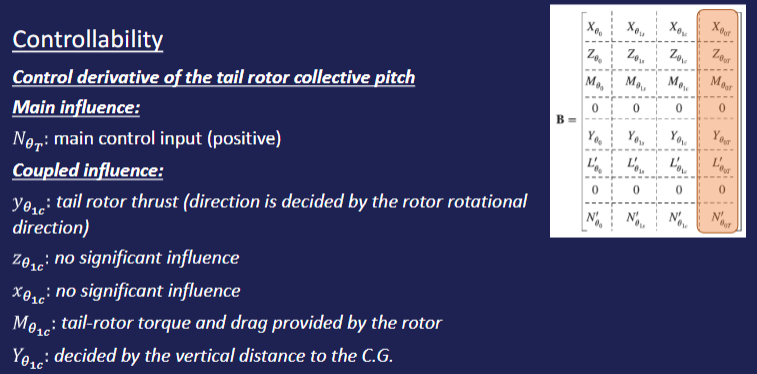
56
New cards
What power components form the overall power consumption of the helicopter?
Induced power consumption provides the thrust
Parasite power is used to provide the propulsive force to balance the drag
The profiling drag is related to the airfoil aerodynamics design and rotor design
\
Parasite power is used to provide the propulsive force to balance the drag
The profiling drag is related to the airfoil aerodynamics design and rotor design
\
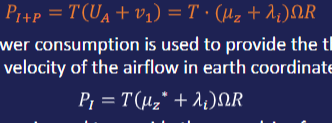
57
New cards
What is the ground effect and its influence on helicopters?
Its the power required to leave the ground often determines the the aircraft maximum takeoff weight.
The ground plane constrains the aircraft wake.
The rotor vortex wake has a reflected image that induces an upward flow at the rotor disk.
It increases rotor thrust for a given available power.
This effect is controlled by the ratio of the rotor radius to its height above the ground.
The ground plane constrains the aircraft wake.
The rotor vortex wake has a reflected image that induces an upward flow at the rotor disk.
It increases rotor thrust for a given available power.
This effect is controlled by the ratio of the rotor radius to its height above the ground.
58
New cards
Key issues that give boundaries of the helicopter flight limit
Retreating blade stall
Advancing Blade shock induced separation
Vibratory loads outside the fatigue spectrum assumptions
Blade tip stall in near axial flight
Maximum equivalent airspeed
Advancing Blade shock induced separation
Vibratory loads outside the fatigue spectrum assumptions
Blade tip stall in near axial flight
Maximum equivalent airspeed